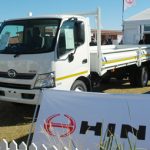Made in China

Over the last five decades or so, Asian manufacturers have been proving their worth and wrecking havoc on local automotive markets. And now, thanks to the Chinese, they aren’t stopping any time soon.
In her November 2012 Steering Column, FOCUS editor Charleen Clarke wrote that companies across the globe quiver at the mere mention of the name “China”.
This groot gevaar (or big danger), as she described it, has been threatening all sectors of global industry for many years now – mostly flooding global markets with their own cheap goods or copies of well-known products. In the motor vehicle industry, it’s been more of the same … and the industry is (or should be) slowly beginning to notice, and quiver.
In the 1960s and 1970s, Japanese vehicle makers did exactly this. They began to produce both passenger and commercial vehicles for export markets that, no matter what the brand, built a reputation of simple engineering and quality that no one could ignore. Before long, some of the best-selling vehicles in the country were Japanese makes – and still are today.
Then in the 1990s (perhaps even as far back as the 1980s) and early 2000s it was the turn of the Koreans. Motor manufacturers in Korea went through a decade or so of producing vehicles that could broadly be summed up with the words “cheap” and “rubbish”. But you could see that all it would take was a little effort to be among the best. Today, that effort has made vehicles from Korean marques Hyundai and Kia – Ssanyong still seems to be struggling to crack the market – some of the most accomplished you can buy.
So to the Chinese, and you’ll certainly have realised where I’m going with this … Yes, they’re now doing just what the Japanese (almost literally, as many of their vehicles – especially light commercials – have been based on Japanese designs and mechanicals) and Koreans have done.
Ask just about anyone their impressions of just about any Chinese vehicle and their response will be those same two words people liked to sling at the Koreans during the 1990s. And in many instances, yes, the sentiment rings true.
But, and this is a big but, they are putting in the effort. I have noticed that almost every time I drive Chinese vehicles they get better; the most noticeable of which is the vehicle that prompted me to pen this column – the Foton Tunland.
The Tunland (which you can read a full review of in the June edition) is a Foton own design – that is, not a thinly disguised rip-off of an old Isuzu KB. It uses trusted mechanicals from Cummins and Getrag, and not Chinese copies of old Toyota drivetrains.
It attracted more attention than I would ever have thought and, while it did have a few issues that simply should not have been there, it was certainly the best vehicle I have yet driven to come out of China. And they will keep on getting better.
So, if you’re still passing Chinese motor manufacturers off with a scoff and a sneer, don’t. Those days are coming to an end. Indeed, watch them closely; because their vehicles are making a very strong case for themselves.
Published by
Focus on Transport
focusmagsa




